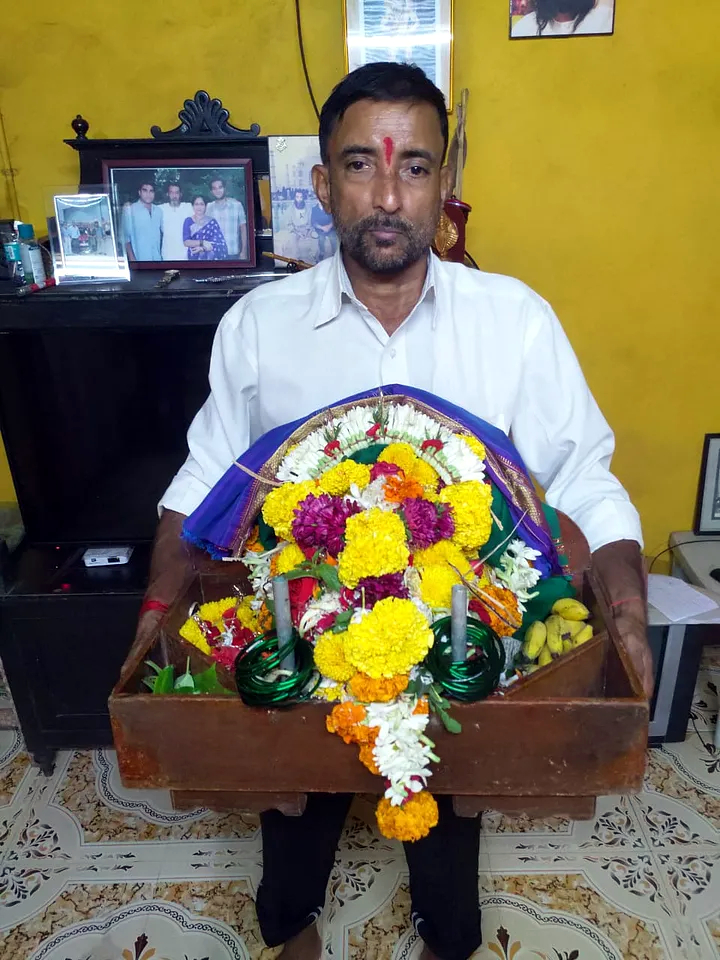
Gaokar carrying the peth (altar) of Sangeli Devi in Sanvordem.
Ashadhi Purnima, or Guru Purnima, is a day of worship and celebration for Hindus all over Goa. A unique festival dedicated to the worship of a pre-vedic God, Sangeli Devi, is celebrated in Sanvordem during this period.
This year, the festival of worshipping Sangeli Devi will be celebrated in four days, starting from the auspicious day of Ashadhi/Guru Purnima on July 18 and ending on July 21.
ORIGINS
Suraj V Laad of Dattawadi-Sanvordem, the husband of my friend, Suvarna, enlightened me about religious practices in Goa in the pre-Vedic times.
He said that back then, Hindus in Goa worshipped five ancient local deities (Panchishtan). It is believed that these five deities were guardians of vast areas, locally known as ‘Vaatar’ or ‘Moll’. Each deity was assigned to guard a Vaatar (area) and all inhabitants residing there.
These five deities were Naagnath (snake god/incarnation of Lord Mahadev), Betal (protector deity), Sateri (Goddess of the ant hill), Sangeli (protecting goddess) and Kshetra Pal (guardian of the farmland).
Since the pre-Vedic era, our ancestors have worshipped these deities on specific days of the year and celebrated that day as a festival day. On that day, they would present some gifts in the form of offerings to these ancient deities as a mark of respect and gratitude for being their guardians.
All these five deities were considered Gods of the ancient Panchayatan and their rituals were performed by the Gaokar (village headmen and a descendant of the original resident of a village since the pre-Vedic era) and the Adel (ancestor).
The worship of these Panchistan (five ancient deities) has continued in modern times. The Gaokar and Adel are still summoned to perform rituals of these ancient deities and to perform other village rituals.
RITUALS
The full moon day in the holy month of Ashadh is a day of worship and celebration. Hindus all over celebrate this day as Ashadhi Purnima or Guru Purnima, a day to worship one’s Guru (teacher). On this day, they honour/worship their spiritual teachers who have enlightened them. They also honour all other teachers who have taught them values and imparted knowledge. For the Hindus in Sanvordem, Guru Purnima is an extra special day. Besides the worship of their Gurus, Hindus living there also worship the pre-vedic deity Sangeli Devi, known as Vanadevi (goddess of the forest).
Suvarna described the celebration of rituals of the Sangeli Devi festival. On the day of Ashadhi Purnima, also known as Guru Purnima, the idol of Sangeli Devi is brought by a Gaokar, the village headman. He is a descendant of the original resident of Sanvordem since pre-Vedic times.
He brings Sangeli Devi from a Ghumti (small temple) situated deep in the woods. The idol is brought by him on a wooden Peth (altar) decorated with flowers. He is accompanied by other villagers who take Goddess Sangeli to every Hindu house in Sanvordem.
In each house, a Puja of the goddess is performed and is worshipped by family members. Suvarna mentioned that in houses belonging to the Saraswat Brahmin community, the Puja is performed by a Pundit/Bhatt (priest), whereas in houses belonging to other castes, it is performed by the Gaokar himself.
After the Puja, the main Savashin (married woman) in a house offers the goddess a Votti, an offering comprising a coconut, Khann (cloth material for a blouse), some flowers and fruits.
The Gaokar and other villagers accompanying the Peth are offered refreshments like tea, fruits, and even food at times, while the pundit is offered Dakshina (gifts and cash).
The Savashin prays to the goddess for the well-being of family members and makes a Navas (vow) to be fulfilled if the Goddess Sangeli grants her wishes. The other family members pray for the Sasay (blessings) of the goddess upon them.
In the past, Sanvordem had few houses and the visit of Sangeli Devi to all houses was completed within a day. The Peth with the deity would return to the Ghumti in the woods, late in the evening of the same day. Now, the number of houses has grown so much that it takes about three-four days for the Sangeli Devi to visit all of them.
FOLKLORE
Suvarna also recalled an interesting Akhyaika (folklore) about Sangeli Devi, narrated to her in her childhood by an elderly aunt.
Several decades ago, the Gaokar who carried the Peth of the goddess on this festival, reached the Devi back to her Ghumti in the woods late in the evening of the Ashadhi Purnima.
On returning home, he realised he had left his Koiti (sickle) behind. He turned back and reached the Ghumti in the woods, in darkness. There, he saw the Sangeli Devi serving food to the Bhutha (ghosts/spirits). On seeing the Gaokar there, the Devi pulled him aside and hid him in her saree. She did this to protect and keep him safe from the ghosts/spirits present there.
The next morning, she set him free to return to his house. She made him promise not to disclose this incident to anyone and warned him that if he broke this promise he would die instantaneously. The Gaokar kept his promise throughout his life and never disclosed this incident to anyone, till he was old and on his deathbed. That is how all worshippers know this anecdote about Sangeli Devi.
- The writer is an architect by profession and is passionate about festivals and traditions in Goa